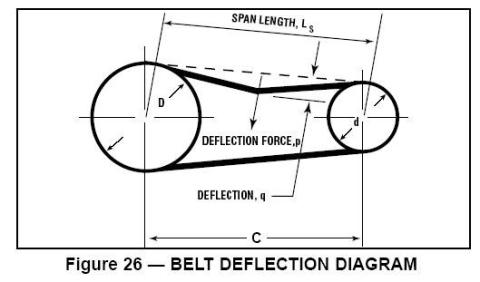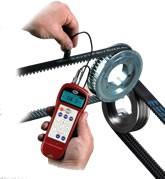Measuring driving belt tension
Gates Belt Tension Tester
Tension testers are used to check the tension of Synchronous belts and V-belts.
How do I tension a belt?
- The best tension is a low one, at which the belts won't slip under the heaviest loads. You can gradually tighten the tension, making sure there's no tooth skipping.
- Caution: excessive tension generates noise and premature wear.
- For V-belts, check tension frequently, especially on the 1st day of use. Synchronous belts, on the other hand, need not be checked.
- V-belts should be checked periodically.
- Belts and Pulleys must be kept free of foreign objects.
- If a V-belt slips, retighten it.
Sonic tensiometer for driving belts
With Gates' Sonic Tension Tester, you can easily obtain consistent and accurate tension readings.
The Sonic Tension Tester operates by analyzing the sound waves produced by a vibrating belt. A belt vibrates at a certain frequency, determined by its tension, mass and strand length. The tensiometer translates this frequency into a tension value.
Compact, lightweight and easy to use
This compact blood pressure monitor fits in the palm of your hand. Battery-operated, it comes with a flexible sensor. Two types of sensor can be used: sonic or inductive. A wired sensor is also available.
- Important warning: always switch off the transmission before using the 508C tensiometer.
- Use the numeric keypad to enter the weight per unit length of the belt (supplied with the user manual), and the width and length of the strand. These data remain in the unit's memory.
- Bring the small sensor close to the strand and lightly tap the belt to vibrate it.
- Press the "Measure" button. The computer measures the frequency by means of the variations in sound pressure produced by the belt and calculates the tension. The tension value is displayed in Newtons. Results can also be displayed in Hertz.
Gates® sonic tensionmeter video:
Timing belt tension measurement and pre-tensioning method
If the belt is sufficiently short and free (not resting on a sliding sole), you can use the same devices as for a driving belt. Otherwise, there are no devices for measuring installation tension.
If you don't have a calculation note or information from the supplier, you can keep these two basic rules:
- The default voltage can be a maximum of 30% of the admissible load
- In general, the maximum tension generates 1 per thousand of elongation
How to tension a Timing belt?
- The best tension is a low one, at which belts won't slip under the heaviest loads. You can gradually tighten the tension, making sure there is no tooth skipping.
- Caution: excessive tension generates noise and premature wear.
You can mark the Belt (e.g. at 5000mm), and measure its elongation. For a 5000mm length, the maximum elongation should be 5mm. If you don't have heavy loads, stick to 3mm..



